Women of Ink: The Power of Female Traditional Tattooists in Southeast Asia and Beyond
What is the role of women in tattoo revivals across globalising Southeast Asia? How are traditional tattooists more than artists? In this multivocal article, we address these questions and reflect on our ongoing photography project on traditional tattooists in contemporary contexts.
Practised among various Indigenous cultures, traditional tattooing is a manual tattooing process using handtapping or handpoke techniques, in which the tattooist rhythmically taps or pokes ink into the skin dot by dot, accumulating into lines and intricate designs.
At the International Conference of Asia Scholars 13 (28 July – 1 August 2024), hosted by IIAS and Universitas Airlangga in Surabaya, we curated a photography exhibition inspired by Talisha’s Research Master's project "Reclaiming Inked Indigeneity in Indonesia." European colonialism, state-led modernisation, and capitalist market forces marginalised many tribal tattoo traditions. Mainstream discourse often emphasises their ‘near extinction’, while disregarding the agency and power of traditional tattooists. This understanding motivated us to showcase a diverse selection of eight portraits captured by Nadja during the Borneo Handtapping Tattoo Weekend (BHTW) 2023, 1 foregrounding the stories of handtapping tattooists that revitalise tribal tattoo traditions from Mentawai and Borneo. Each portrait was accompanied by the tattooist’s profile, drawn from semi-structured interviews. Together, these visual narrative elements offered visitors a glimpse into the life trajectories and independent research activities of traditional tattooists, highlighting the critical role of such artists in preserving Indigenous heritages while adapting to new contexts and meanings.
After the ICAS 13 exhibition, we joined the BHTW 2024 as event crew members, where we witnessed an interesting shift. While the first BHTW featured two female traditional tattooists, Tipung Puyang and Meraki Fade, the second edition saw greater participation of women. This reflects the rising role of women in traditional tattooing across globalising Southeast Asia – a shift that deserves more attention. Historically, many Indigenous tattoo traditions in Asia were either female-dominated or had a gender balance. These contrast sharply with the male-dominated niche of traditional tattooing in today’s global tattoo industry. At the BHTW 2024, Nadja captured the portraits of all traditional tattooists involved. However, we wish to centre the power and agency of female tattooists in this article, inviting readers to connect with their stories as they challenge different power structures. We constructed the first-person narratives that follow from conversations with each of the female tattooists, based primarily on their responses to a set of open-ended interview questions, and with their explicit consent to write and publish these accounts.
Talisha Daisy Dionysius Schilder is a student researcher in the ResMA Asian Studies programme at Leiden University. Her critical ethnographic research explores contemporary practices of Indigenous tattoo traditions in Southeast Asia, especially Indonesia. Email: t.d.d.schilder@umail.leidenuniv.nl
Nadja Ritter is a freelance photographer. In 2011, she obtained her degree in Photography “Abschlussklasse Ute Mahler” at Ostkreuzschule für Fotografie in Berlin (Germany). She documented Indigenous tattooing practices and lifeways in Mentawai and Borneo during the tattoo expeditions of her partner and Indonesian tattooist Aman Durga Sipatiti. Email: me@nadjaritter.de
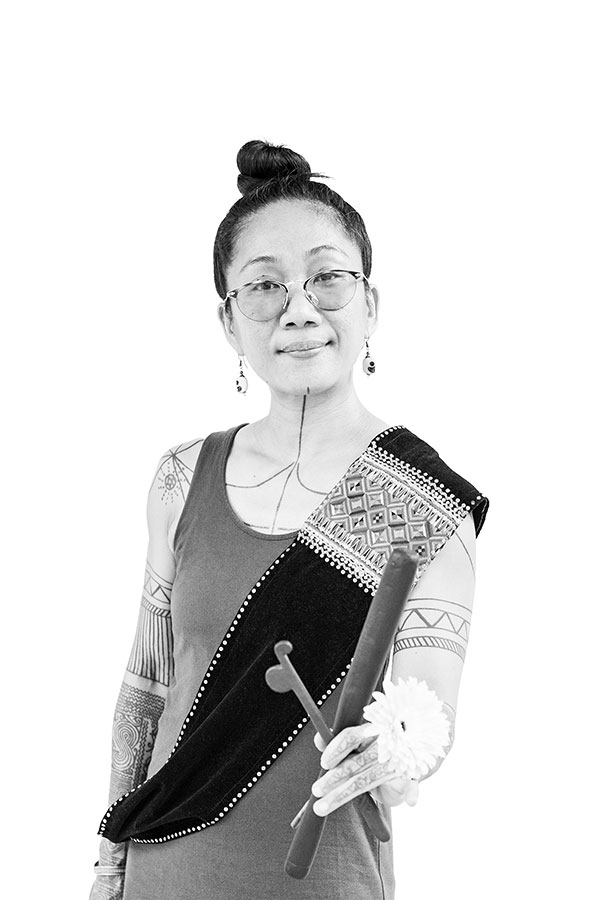
Tipung Puyang
Born in Kota Kinabalu (Sabah, Borneo) and Indigenous to a Dusun village, I am a self-taught female tattooist. Mother’s tribe: Lotud of Tuaran, keeper of grandmother’s beads. Father’s tribe: Tindal of Kadamaian, keeper of grandmother’s trees. I started learning about traditional tattooing through my job at the Indigenous Peoples Network of Malaysia (JOAS). Since 2012, I have been a full-time Indigenous artist, travelling across Southeast Asia and Europe while selling crafts, performing arts and traditional music, hosting workshops, and running cultural projects. I embarked on my journey as a traditional tattoo practitioner in 2019. My tattoo work exclusively uses handtapping techniques and embodies the balance between humans and nature.
Traditional arts and tattooing are integral to my advocacy for Indigenous rights to ancestral lands and resources because Indigenous cultural practices are deeply intertwined with nature. The contemporary revitalisation of traditional tattooing is an important testament to our resilience to still exist and survive while adapting to the modern world with a sense of duty and honour. For Indigenous people in today’s globalising world, contemporary art such as tattooing is our platform to voice and express ourselves as we did for centuries with our traditional arts. In the same way we use our music, dance, costumes, and crafts, our tattoos hold the knowledge, stories, and meanings relevant to our cultural survival today. We often speak of the Mother tongue, Mother Earth and Mother land. I feel, it is this feminine energy regardless of gender, that is reflected through my traditional tattooing practice.
Tipung Puyang is based in Orangutan Tattoo Studio in Kota Kinabalu, Sabah / Malaysia. Her tattoo journal on Instagram is at @rainforest_ink.
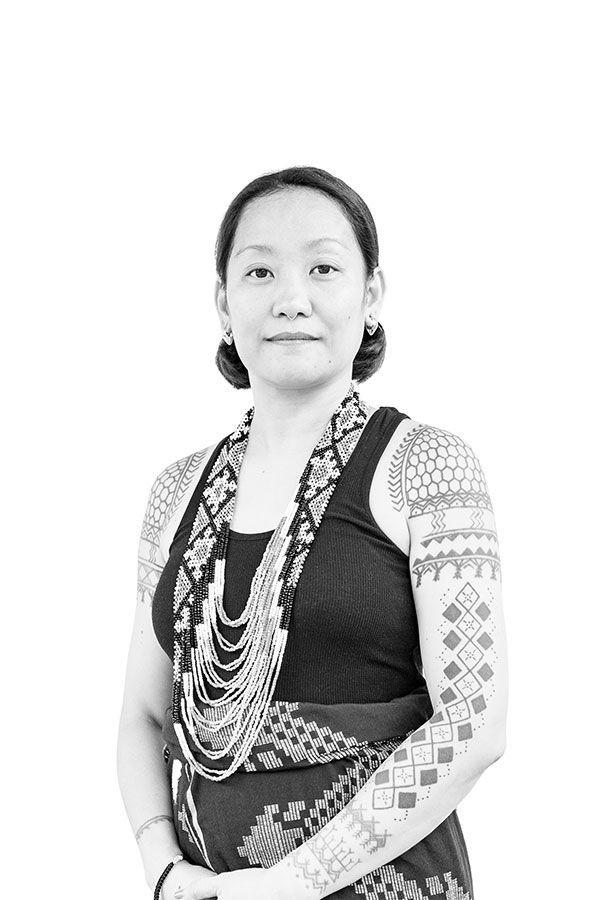
Jean Sioson
Born and raised in the Philippines, I am proud to be the only female traditional tattoo practitioner in Manila. With over 15 years of experience, I practise handtapping tattooing while continuously researching Indigenous tattoo motifs in North Luzon, the Visayas, and Mindanao, especially those of the Moro and Manobo communities. I feel that I am here to serve a larger purpose than aesthetics or tattoo tourism. For me, traditional tattooing is an assertion of precolonial Filipino identity. Our ancestors’ unique tattoo patterns and methods tell stories that bridge the past with the present. Preserving our ancestral tattoo traditions, heritage and culture can give us a sense of belonging and social values that makes us better people.
As I face the capitalist rat race in the big city and lingering colonial mindsets, a contemporary challenge for traditional tattooing in today’s globalising world is balancing art, Indigenous culture, and consumerism. We can achieve this balance through ethical research, reciprocity, and respect for tradition. As a non-full blood Indigenous woman, my identity presented another challenge in this field. Despite my genuine passion and years of experience, some people questioned my authenticity. Instead of letting their negativity define me, I used it as a positive drive that helped me master my craft, travel the world, and connect with like-minded people. Over time, my traditional tattooing practice became authentic in its own way.
Jean Sioson is located in Pasig City, Manila, the Philippines. Her work can be seen on Instagram @jean_katributatu_mnl.

Nagaia
While there is a strong presence of women in the global tattoo industry, my direct work environment is still male-dominated. I am the only female Dayak traditional tattooist practising handtapping in Sarawak. After two years of self-taught tattooing, I took on a tattoo apprenticeship that led me to specialise in Iban [Dayak] Pua Kumbu tribal motifs from Borneo.
During my university years, I started tattooing all kinds of designs without a clear focus. That changed when my father critically asked me: “Why are you not tattooing our ancestral tribal motifs? We are Dayaks, native to Borneo. Why bother tattooing Western designs?” His words still echo in my mind. While Western tattooists create incredible Dayak tattoos, why should we, as Dayaks, not do the same? It is our birth right to preserve and share our ancestral tattoo tradition with knowledge passed down from our elders. I wish for more local and native women, including myself, to revitalise Dayak tattoo traditions respectfully and with proper knowledge. Unfortunately, I endured a great deal of heckling from men. Perhaps my traditional tattooing practice triggers male insecurities, but this is not my intention. I want all Dayaks to thrive together in the world of tattooing and make tribal Borneo great again, especially in its homeland.
Nagaia is based in Kuching, Sarawak, Borneo. Tattooing at Rakta Dhatu Tattoo, her work can be viewed on Instagram @nagaiatato.
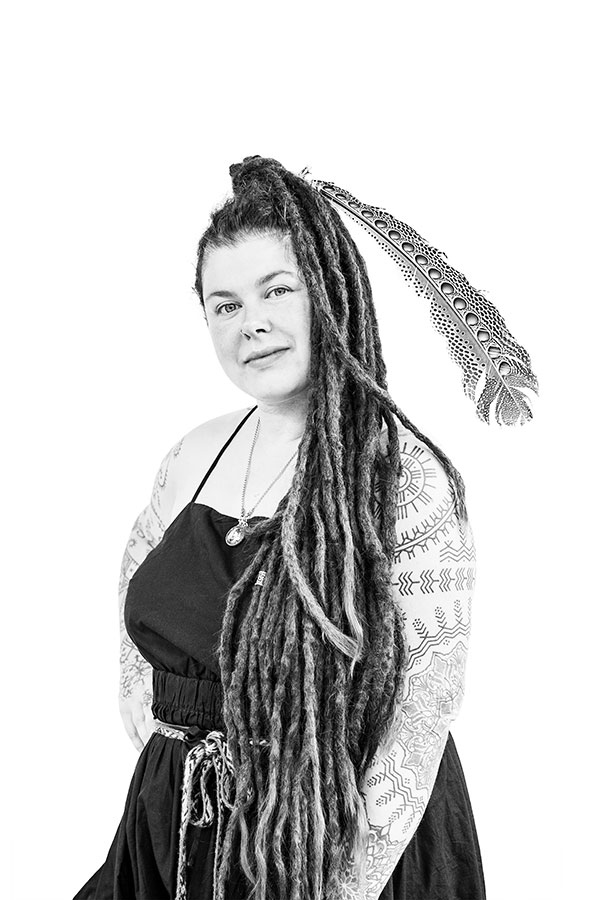
Zaneta – Historical Tattoo
Born in Świnoujście, Poland, by the Baltic Sea, I have spent the past 12 years specialising in bold, ornamental designs and handpoke tattooing. Baltic motifs stole my heart because they connect me to my grandfather, who was born in Lithuania. My artist name, Historical Tattoo, embodies the intersection of historical research practices – archaeological sites, archival materials, museums, and oral history – with my passion for ancestral heritages, cultural preservation, art, and identity celebration.
Science, tattooing, and art are a perfect match. With an academic background in biology, genetics, and medicine, I better understand the body and mind, enabling me to respond more effectively to my clients' needs. After completing my doctoral studies, I started travelling to find new historical inspirations and to meet tattoo masters from different countries. Observing them at work, I realised that tattooing requires constant learning and skills improvement. Combining historical and ethnographic research whilst learning directly from Indigenous tattoo masters allows me to merge motifs and shapes into endless combinations with the utmost respect for tattoo traditions and tribal agency. I aim to create my own (historical) tattoo language, primarily focusing on solid linework done without a machine.
The tattoo industry, particularly the traditional side, is often associated with masculinity. By occupying this space, I believe I contribute to broadening the scope of what tattoos can represent, not just in terms of design but in how they relate to identity, personal expression, and spirituality. Embracing femininity in my tattoo work, I hope to redefine what it means to be "feminine" in a space that has long been dominated by masculine codes.
Zaneta can be reached via Facebook (“historicaltattoo”), and her work can also be viewed on Instagram @historicaltattoo.
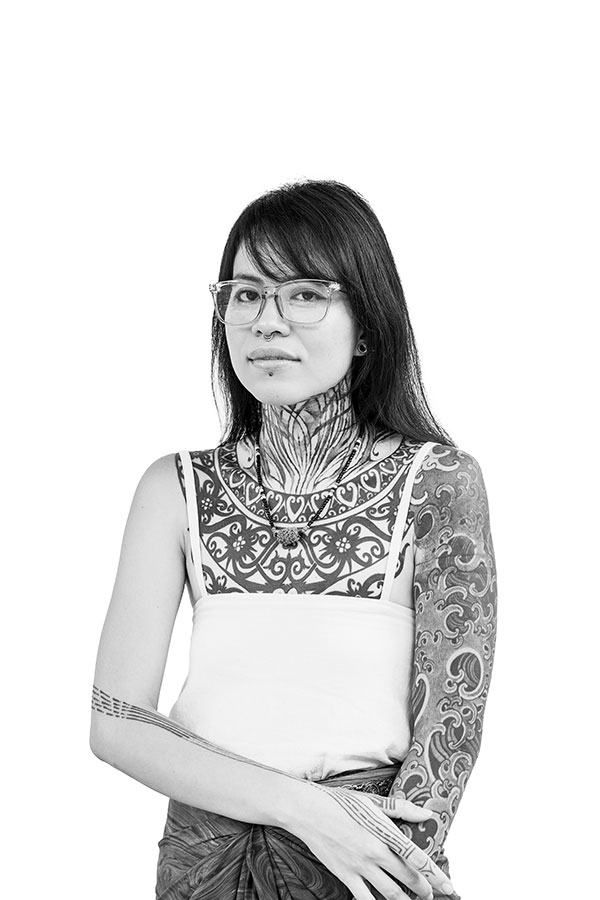
Nessy Voon
In today’s world, where people often come from mixed backgrounds or are born in places different from their ancestral roots, I hope my tattoo work inspires others to see that we belong to where we are born, regardless of race. I used to feel lost. I thought that I had no right to focus on Bornean motifs because I am pure Chinese. However, friends and peers reminded me that being born and raised in Borneo makes me Bornean. I specialise in handpoking Bornean tribal motifs with Chinese textile patterns, which reflects my identity as a Chinese-Bornean woman. My work embodies unity in cultural diversity, (re)connections with ancestral lands, feminine energy in nature, and collaborative learning.
Tattooing is not only art but also empowerment. In a traditionally male-dominated industry, I aim to challenge stereotypes and create a space where women can express their strength and individuality. I hope this article encourages more women to venture into traditional tattooing, without fear or insecurity about male opinions. Despite progress, it’s still not always safe for women in the tattoo industry. I endeavour to build a safe space, not only for my female clients but also for new female tattoo practitioners. I don’t mind being accused of favouring women or judged for creating such a space—if that’s what it takes to make women feel safe and empowered, I accept the judgment.
Nessy Voon is based in Malaysia and is currently freelance tattooing and travelling between Kuching and Kuala Lumpur. She can be reached through Instagram @nessyvoon.
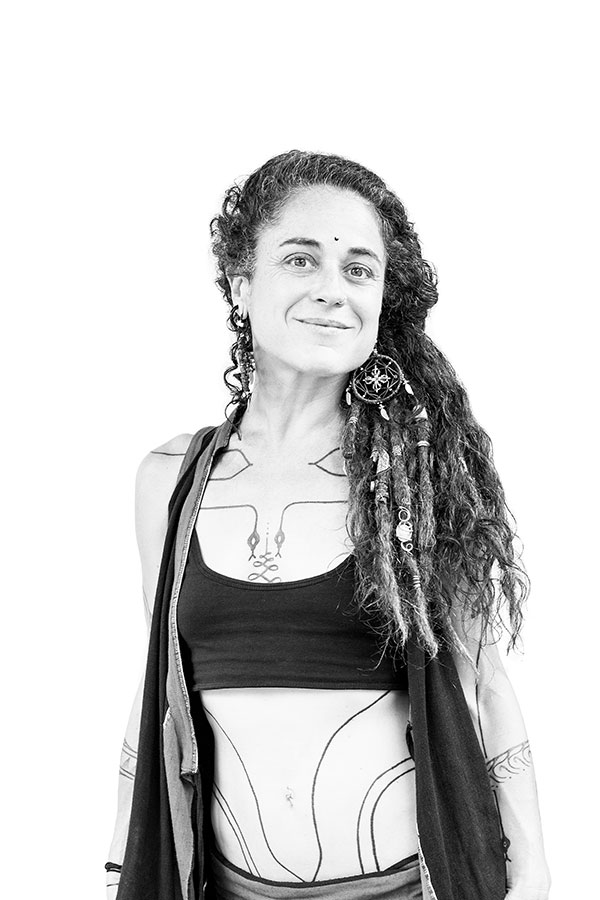
Luli
I have been a nomad and travelling artist for most of my life. Spirituality is at the core of my identity, approaches, artistic practices, and tattooing. I began my tattooing journey with an electric machine in 2010 but transitioned to handpoke tattooing during a trek in the Himalayas in 2017, where I connected with the spiritual power of the surrounding nature. For the past months in Borneo, I have been a handtapping tattoo apprentice under the guidance of Dayak and Mentawaian handtappers, and the Kenarau tattoo family who revive Dayak tattooing to resist colonial legacies. I also lived with the Lahanan tribe in Asap (Sarawak, Borneo) for a month, immersing myself fully in their cultures and lifeways.
Preserving Indigenous tattoo traditions today is crucial when tattooed elders can still share their stories. This belief drove me to initiate my Newar Tattoo Project in Bhaktapur, Nepal, in 2017, addressing the lack of archival materials and documentation. I aim to keep ancient tattoo patterns and traditions alive for future generations to connect to their ancestors’ stories. I was born in Spain – a place without known tattoo traditions. Only with permission and by invitation of the local communities I lived with, I tattoo the ornamental designs, powerful symbols, and sacred geometry patterns from the Asian cultures I study during my travels across the region.
Luli spends her summers in Gudvangen Viking Village in Norway, where she exclusively performs traditional tattooing. Her work can be viewed on Instagram @luli_tattoo.